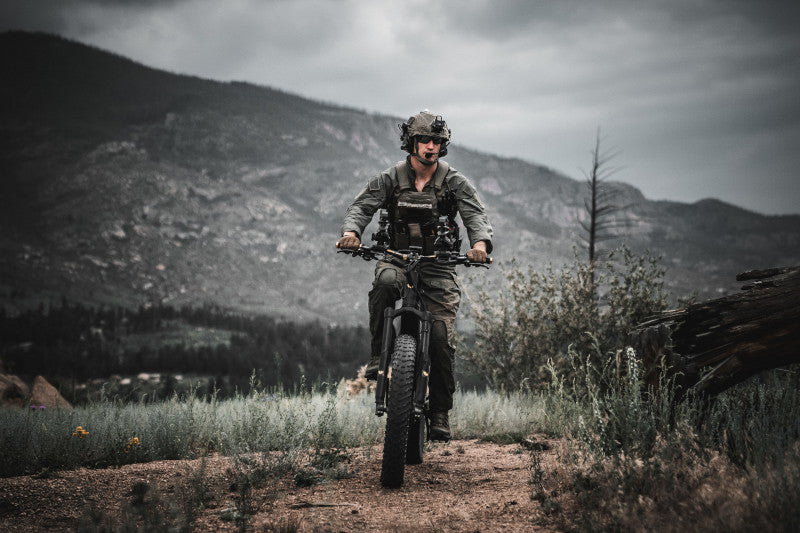Before you take a deep dive into everything an electric bike can offer you, first consider how you will primarily be using it and where else in the world you’d like it to perform. For example, if you live relatively close to the grocery store and want to reduce your carbon footprint by leaving the car out of the equation but also like to ride mountain bikes on the weekend, you might want to opt-out of an e-cargo bike and make sure you’re looking for a full-suspension bike that also is compatible with grocery-carrying accessories.
We’ll admit it: we can’t imagine getting fired up about anything that’s not from the lineup of QuietKat electric bikes, but even still, we’ll break it down to the basics with the top 10 things to look for in an electric bike.
1. Class (I, II, II)
Understanding the language around e-bike classification is imperative for making sure that you’ll be able to enjoy the trails, wild spaces, and urban biking in your area. Because much of the legislation around e-bikes are left to state and local authorities, we highly recommend you do some quick research to better understand what you’re hunting for before you start your search.
In short, e-bikes are classified as follows:
Class I: Pedal-assist only, no throttle, max assisted speed is 20 mph.
Class II: Max speed is still 20 mph, but the bike is pedal assisted and features a throttle.
Class III: Like Class I, pedal-assist only, with no throttle, and the max assisted speed is 28 mph.
Note that it’s understood that all classes limit the motor’s power to 1 horsepower.
2. Range
Having a strong understanding of the range of your new electric mountain bike can be the difference between having a nice day in the woods and hiking out or e-grinding with your 50 pound bike. Our advice: make sure you’re well aware of the range on your new e-bike and that you’re able to keep an eye on the battery life. Additionally, it’s wise to use an app like Strava to track your miles so you know when you’re getting close to the maximum projected range.
Also, investing in a high-powered backup battery pack like the QuietKat Pathfinder means that only nine extra pounds gets you up to 36 extra miles. That, to us, is well worth the weight.
3. Motor
There are four major stats that converge to paint a complete understanding of just what you’re getting out of your e-bike motor. For a full crash course, check out EBike Motors, Explained on Bicycling.com.
Watts: This tells you how much energy the motor can consume continuously. Most likely the first rating you’ll see is the continuous watt rating which differs from the peak rating.
Amp: Think of e-bike amps as kind of like the horsepower of your car—it tells you what your bike’s max output is.
Amp Hours: If amps are like horsepower, amp hours is like your fuel tank. The higher the amp hours, the longer the battery life.
Volts: When it comes down to it, volts basically equate to power, indicating how powerful a battery can be and giving you a fairly good idea of top speed.
4. Gears
If you live in the midwest and are looking forward to cruising on your new e-bike around relatively flat trails, then fewer gears are a go for you. But if you find yourself wanting to climb some serious altitude like in the Cascades, the Rockies, the Blue Ridge Mountains or the like, the difference between 7 and 9 gears can be stark.
Even if you’re just planning on riding your e-bike in a hilly city, you can create a much more pleasant riding experience for yourself if you invest in an extra few gears.
5. Suspension
We’ll outright say it: no matter what you’re planning on riding, going fully rigid isn’t a wise choice. Having some suspension—even if you opt into a hardtail—can greatly improve the comfort of your ride. And more comfort = more riding.
A hardtail bike only features fork suspension, or suspension over the front wheel of your bike. A full-suspension bike also features a shock that typically sits just in front of your back wheel. Full suspension bikes are designed for trail riding. They’ll smooth out a ride to the point that tall roots and grapefruit-sized boulders are a surprising cinch. Assess what terrain you’re going to tackle, and decide about suspension accordingly.
6. Dropper Post
If you’re headed off road or planning on doing any trail riding, a dropper post is a truly valuable upgrade. This dovetails with proper riding technique: when you’re climbing, your saddle should be high enough that your leg is nearly fully extended on the down stroke. But when you descend, a dropper post gives you the ability to lower your saddle, thereby giving you much more freedom of movement.
Other Things to Look For in an Electric Bike
Again, depending on your desired use, other things to keep in mind are towing ability and accessory pairing. If you’re considering bikepacking or hauling out an elk, make sure your new e-bike has compatibility with pannier bags cargo trailers.
Additionally, look out for weight, frame size and type (they even make folding e-bikes these days!), quality of brakes, and more.



 USA
USA Canada
Canada




